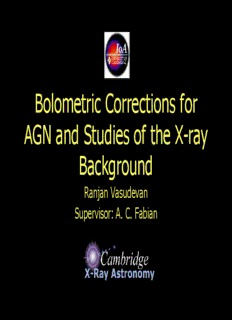
Bolometric corrections for AGN and studies of the X-ray background PDF
Preview Bolometric corrections for AGN and studies of the X-ray background
Bolometric Corrections for AGN and Studies of the X-ray Background Ranjan Vasudevan Supervisor: A. C. Fabian The Big Picture (1) • The hard X-ray background (XRB) spectrum is understood to be the total emission due to accretion from AGN; • Established convincingly by observations (e.g. Hasinger 2004); • Can use XRB to infer SMBH mass density ρ Eddington BH, ratio of AGN, λ and mass-to-light conversion efficiency, Edd η Emission from AGN gives rise to… XRB spectrum But many details are uncertain… The Big Picture (2) • It is also useful to compare past AGN activity with what the distribution of SMBHs in the local universe to see if "present day" conditions follow on simply from past conditions. • For this exercise we require AGN and local galaxy luminosity functions. Give rise to this? (Present day SMBHs in galaxies) Does this (past AGN activity)… The Specifics (3) • For these studies we are clearly interested in the total luminosity due to accretion emitted by a object. We require one crucial input before attempting these studies… The bolometric correction This correction is needed so that we can scale up the XRB light to get the true luminosity due to accretion. It can also be used to scale up the luminosities seen in luminosity functions. Previous work (1) • The quasar SED presented by Elvis et al (1994) has been adopted by many as the "canonical" quasar SED by many in the field - a mean quasar SED calculated from observations of 47 quasars. • Dashed line: radio loud, solid line: radio quiet • We can see some of the main spectral features common to AGN: UV/optical "big blue bump", power law in hard X-ray • Disadvantage: the dispersion in this mean SED is large due to the diverse spectral shapes of the individual quasars Previous work (2) • Elvis et al have determined bolometric corrections from this SED, but their bolometric luminosities include IR emission, which is known to be reprocessed from the UV (Antonucci 1993) so their bolometric corrections "count radiation twice" UV disk emission (very schematic!) Re-processed IR emission from gas, dust Previous work (3) • Marconi et al (2004) identify this problem, and suggest calculating bolometric corrections without the IR emission • They construct a template spectrum for AGN from a set of power laws and enforce the relationship between the spectral index connecting X-ray and optical, , and OX luminosity (Vignali, Brandt and Schneider 2003) • Disadvantage: No window onto the actual variation of bolometric corrections in the real AGN population. Investigating the Distribution of Bolometric Corrections (1) • We have attempted to construct SEDs for a sample of "local" (z<0.7) AGN to calculate their bolometric corrections • Our sample is drawn from the 85 AGN observed by FUSE as presented in Scott et al 2004, which allows the inclusion of UV points where the blue bump dominates. Optical points were gathered from HST, KPNO (Shang et al 2005, Baskin & Laor 2005) with X-ray data points obtained from the Tartarus Database of ASCA observations (Nandra et al, Imperial College) and a host publications providing XMM and ROSAT observations. Investigating the Distribution of Bolometric Corrections (2) • We then fit disk and power law models to the points (diskpn + powerlaw in XSPEC or suitable variant) and determine bolometric corrections from the fit. • In order to constrain the physics underlying the disk emission, we have used SMBH mass estimates to fix the normalisation of the disk component, from Kaspi et al (2000), McLure & Dunlop (2001), Baskin & Laor (2005) and others. Results so far (1) Plot: bc vs 2-10 keV lum
Description: